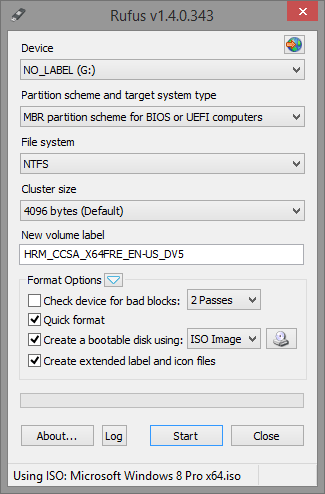

- Iso to usb windows 10 bootable how to#
- Iso to usb windows 10 bootable install#
- Iso to usb windows 10 bootable upgrade#
Iso to usb windows 10 bootable install#
Quick tip: If you plan to install Windows on multiple computers running 32-bit and 64-bit architectures, use the "Architecture" drop-down menu and select the Both option to create a media that will work on both systems. Select the correct language, architecture, and edition of Windows 10 (if applicable). (Optional) Clear the Use the recommended options for this PC option. Select the Create installation media (USB flash drive, DVD, or ISO file) for another PC option. Click the Accept button to agree to the applicable license terms.Double-click the MediaCreationToolxxxx.exe file to launch the setup.Under the "Create Windows 10 installation media" section, click the Download tool now button to save the file. To create a Windows 10 USB media, connect a flash drive of at least 8GB of space, and then use these steps:
Iso to usb windows 10 bootable upgrade#
On Windows 10, the Media Creation Tool is the option available for creating a bootable USB media to perform an in-place upgrade or clean installation.
Iso to usb windows 10 bootable how to#
How to create Windows 10 UEFI boot media with Media Creation Tool How to create Windows 10 UEFI boot media with Rufus.How to create Windows 10 UEFI boot media with Media Creation Tool.In this Windows 10 guide, we will walk you through the steps of creating a USB flash drive that includes support for UEFI using the Microsoft Media Creation Tool and Rufus. Or you can use Rufus, a third-party tool that makes it easy to create a flash drive to install Windows with support for UEFI.

You can use the Microsoft Media Creation Tool to download the files onto a removable storage with support for both firmware types (UEFI and legacy BIOS). On Windows 10, you can use at least two tools to create a USB bootable media. However, if you have a device that has a Unified Extensible Firmware Interface (UEFI), instead of the legacy Basic Input/Output System (BIOS), it is crucial to use the correct media for the firmware type to complete the installation successfully. If your system is UEFI enabled then you should select GPT Partition Scheme for UEFI from “The partition scheme and target system type” drop down menu, while creating bootable usb stick or windows boot usb.At the time of installing a fresh copy of Windows 10, you typically use a USB flash drive to launch the "Windows Setup" wizard to continue with the installation process. Rufus is very handy if you want to flash a BIOS or other firmware from DOS or if you want to run any other low level utility.

Rufus also supports creating bootable usb for UEFI boot enabled systems. If you do not have an ISO image and want to create ISO from CD, it is very easy to create with ISO tools or CD burning tools CDBurnerXp and ImgBurn which are freely available. Prior to making a Windows bootable USB or Linux bootable USB you need to have a USB flash drive of minimum 4GB capacity and ISO image file of Windows or Linux etc. Rufus helps format and create bootable usb disk for Windows and Linux both. This tool is portable which means you do not need to install this, just double click on Rufus.exe and it will launch. Rufus is one of the quickest tool among other tools used to create bootable USB from ISO images.


 0 kommentar(er)
0 kommentar(er)
